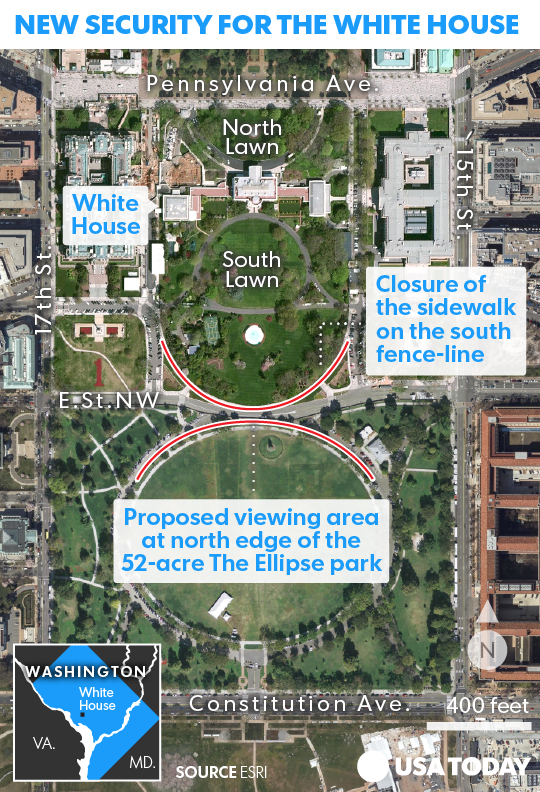Secret Service tightens White House security on south side

WASHINGTON — The Secret Service is enlarging the protective bulwark around the White House complex Wednesday by closing access to the entire fence-line along the mansion's south lawn in the wake of persistent concerns about intrusions.
The new plan, outlined by agency officials, would attempt to replicate a buffer zone created on Pennsylvania Avenue, where iron bicycle racks were placed in front of the perimeter fence to provide officers additional time to react to fence jumpers. That action followed a brazen 2014 breach by a disturbed Iraq War veteran who scaled the north lawn fence and burst through the mansion’s front door.
Under the new proposal, the popular and often-crowded sidewalk bordering the south lawn will be permanently closed to the public beginning at 11 p.m., Wednesday, pushing tourists to the north edge of the 52-acre park known as the Ellipse.
The measures come as the service is confronting a range of security challenges, including increasing encounters with the mentally ill. In the past three years, according to the agency, there have been about 100 incidents in which people have sought to penetrate the 18-acre White House grounds; 95% of those cases have involved suspects with some history of mental illness or emotional disturbance.
Secret Service spokesman Joe Casey characterized the action is part of an "evolving'' strategy to better "mitigate potential threats.'' Contracts for the construction of a taller and more fortified perimeter fence, largely prompted by the 2014 breach, are expected to be awarded later this year.
Prep for the polls: See who is running for president and compare where they stand on key issues in our Voter Guide
Tactics to penetrate grounds
Recent threat assessments, Casey said, have identified a range of tactics that could be used to penetrate the grounds, prompting an ongoing evaluation of current physical security and other safeguards. Among the tactics authorities have accounted for in the continuing examination is the threat of attacks involving vehicles, which have struck targets last year in Europe and most recently in London.
Casey cautioned that such assaults were only one consideration in the analysis.

Secret Service spokeswoman Catherine Milhoan said authorities also considered the implications of imposing further restrictions on public access to the immediate area of the White House. She said vantage points for the throngs of tourists drawn to the location will be preserved.
"This is not going to impede the public's ability to take the iconic photo of the White House,'' Milhoan said. "It's still there. It's just going to be pushed back a little further. We are always trying to balance the desire for access and the security for both the public and those inside the grounds.''
Key to the the decision, Casey and Milhoan said, was to provide agency officers distance between the public and the fence-line to allow for reaction time in the event of an attempted breach, similar to what now exists on the north side of the mansion.
Fence jumpers
Last month, the Secret Service apprehended two fence jumpers in less than 10 days, including one emotionally disturbed 26-year-old California man who scaled barriers on the northeast side of the property late on a Friday night and roamed the grounds for more than 16 minutes before he was discovered. President Trump was in the residence at the time, but he was not threatened..
The incident prompted the firing of two uniformed officers on duty at the time of the late-night intrusion.
A series of prior breaches, notably the 2014 incident, rocked the service, prompting the dismissal of then-Director Julia Pierson, the first woman to lead the agency. Her successor, Joseph Clancy, retired last month after being lauded for restoring stability to the service, while guiding the agency through an unusually demanding period, stretching from the U.S. visit of Pope Francis, the raucous campaign season and the Trump inauguration.
A new director has not yet been named.
The new area of security focus, the south grounds of the White House complex, is on the side nearest the Washington Monument and draws large crowds on the bordering sidewalks, especially on occasions when the president arrives or departs on Marine One.
Milhoan said the area provides little area for officers to maneuver. Just last weekend, she said, agency officers attempted to break up a dispute between two visitors, when a person jumped on the back of one of the responding officers.
"From a security standpoint, it can be seen as a vulnerable area,'' Milhoan said.
Read more:
Secret Service detains man near White House
The White House remains secure: Secret Service
Trump administration blocks access to White House visitor logs